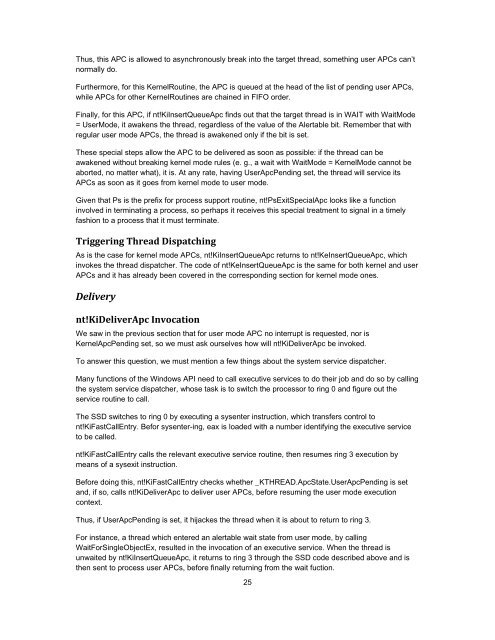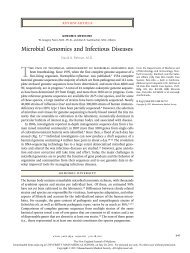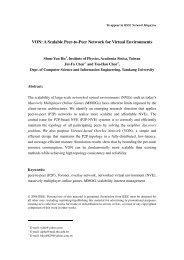366.7 KB - Evernote
366.7 KB - Evernote
366.7 KB - Evernote
Create successful ePaper yourself
Turn your PDF publications into a flip-book with our unique Google optimized e-Paper software.
Thus, this APC is allowed to asynchronously break into the target thread, something user APCs can’t<br />
normally do.<br />
Furthermore, for this KernelRoutine, the APC is queued at the head of the list of pending user APCs,<br />
while APCs for other KernelRoutines are chained in FIFO order.<br />
Finally, for this APC, if nt!KiInsertQueueApc finds out that the target thread is in WAIT with WaitMode<br />
= UserMode, it awakens the thread, regardless of the value of the Alertable bit. Remember that with<br />
regular user mode APCs, the thread is awakened only if the bit is set.<br />
These special steps allow the APC to be delivered as soon as possible: if the thread can be<br />
awakened without breaking kernel mode rules (e. g., a wait with WaitMode = KernelMode cannot be<br />
aborted, no matter what), it is. At any rate, having UserApcPending set, the thread will service its<br />
APCs as soon as it goes from kernel mode to user mode.<br />
Given that Ps is the prefix for process support routine, nt!PsExitSpecialApc looks like a function<br />
involved in terminating a process, so perhaps it receives this special treatment to signal in a timely<br />
fashion to a process that it must terminate.<br />
Triggering Thread Dispatching<br />
As is the case for kernel mode APCs, nt!KiInsertQueueApc returns to nt!KeInsertQueueApc, which<br />
invokes the thread dispatcher. The code of nt!KeInsertQueueApc is the same for both kernel and user<br />
APCs and it has already been covered in the corresponding section for kernel mode ones.<br />
Delivery<br />
nt!KiDeliverApc Invocation<br />
We saw in the previous section that for user mode APC no interrupt is requested, nor is<br />
KernelApcPending set, so we must ask ourselves how will nt!KiDeliverApc be invoked.<br />
To answer this question, we must mention a few things about the system service dispatcher.<br />
Many functions of the Windows API need to call executive services to do their job and do so by calling<br />
the system service dispatcher, whose task is to switch the processor to ring 0 and figure out the<br />
service routine to call.<br />
The SSD switches to ring 0 by executing a sysenter instruction, which transfers control to<br />
nt!KiFastCallEntry. Befor sysenter-ing, eax is loaded with a number identifying the executive service<br />
to be called.<br />
nt!KiFastCallEntry calls the relevant executive service routine, then resumes ring 3 execution by<br />
means of a sysexit instruction.<br />
Before doing this, nt!KiFastCallEntry checks whether _KTHREAD.ApcState.UserApcPending is set<br />
and, if so, calls nt!KiDeliverApc to deliver user APCs, before resuming the user mode execution<br />
context.<br />
Thus, if UserApcPending is set, it hijackes the thread when it is about to return to ring 3.<br />
For instance, a thread which entered an alertable wait state from user mode, by calling<br />
WaitForSingleObjectEx, resulted in the invocation of an executive service. When the thread is<br />
unwaited by nt!KiInsertQueueApc, it returns to ring 3 through the SSD code described above and is<br />
then sent to process user APCs, before finally returning from the wait fuction.<br />
25
















